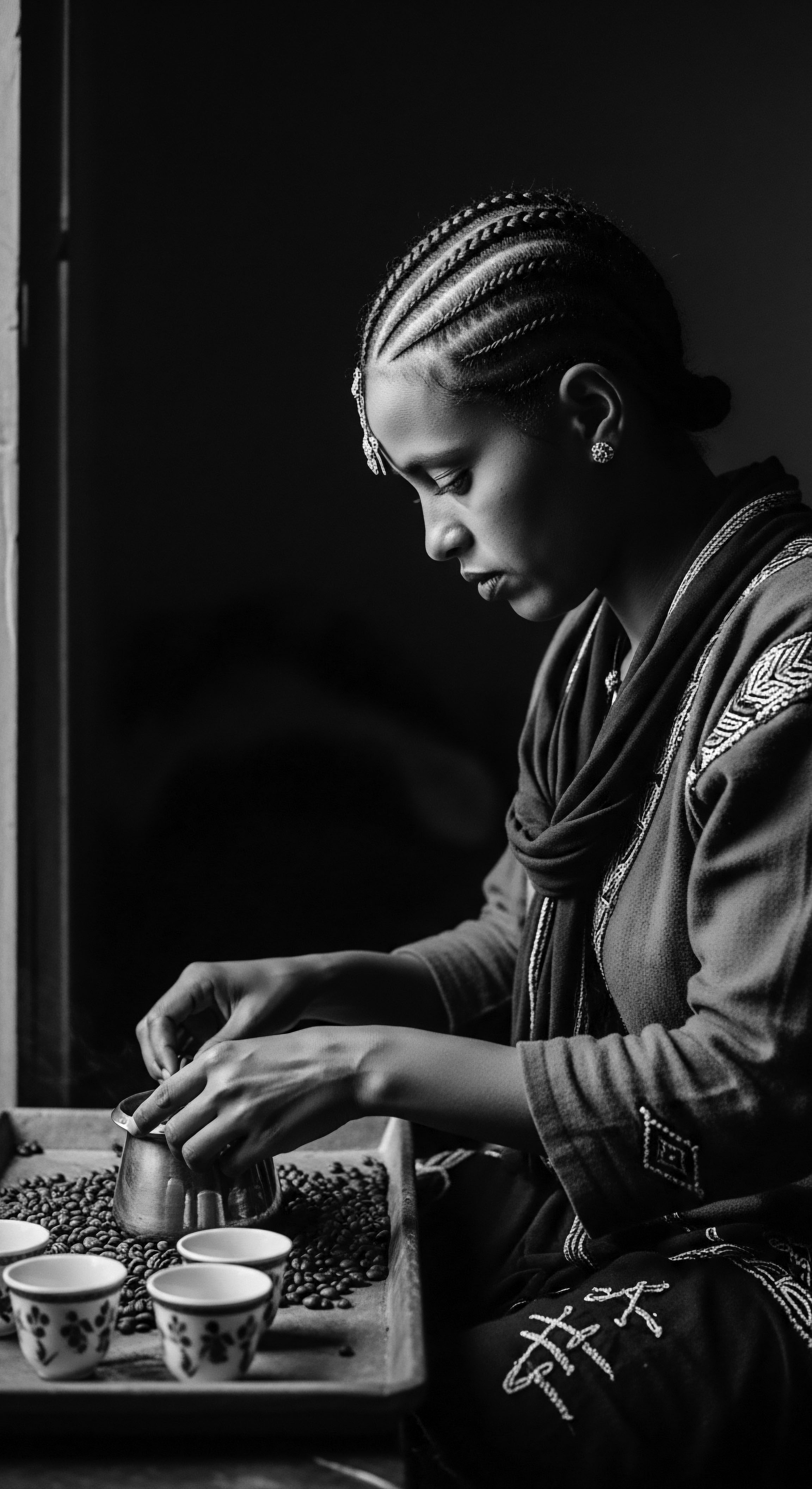
Fundamentals
The Bitter Gourd Oil, an elixir distilled from the fruit of Momordica charantia, a vine belonging to the Cucurbitaceae family, stands as a testament to humanity’s enduring connection with the earth’s bounty. This botanical marvel, recognized by its distinctively bumpy skin and verdant hue, has long been a fixture in traditional pharmacopeias and culinary landscapes across various continents. Its presence stretches from the sun-drenched fields of Asia to the vibrant ecosystems of Africa and the fertile grounds of the Caribbean, a ubiquity that speaks to its remarkable adaptability and the widespread recognition of its inherent properties.
At its elemental core, the Bitter Gourd Oil represents a concentration of the very compounds that grant the bitter gourd its unique flavor and its reputed efficacy. This concentrated form, often obtained through methods ranging from cold-pressing to maceration, allows for a more direct application of its bio-active constituents. The understanding of this oil, at a foundational level, begins with acknowledging its botanical origin and its place within the vast lineage of plants cherished for their contributions to human wellbeing. It is a substance whose straightforward designation, Bitter Gourd Oil, belies a much deeper and more expansive narrative that intertwines with ancestral knowledge systems and the historical pursuit of wellness.
The initial interpretation of this oil might simply categorize it by its source—the bitter gourd fruit. Yet, even at this basic level, the oil’s existence signals a long-standing practice of extracting and concentrating plant properties for specific applications. It is a natural product, born of the earth, carrying within it the legacy of generations who learned to discern and harness nature’s gifts. This fundamental Definition lays the groundwork for appreciating its historical and cultural trajectory, particularly as it relates to the textured hair of Black and mixed-race communities, where natural remedies and ancestral care rituals hold profound significance.
Bitter Gourd Oil, derived from the versatile Momordica charantia, embodies centuries of traditional wisdom regarding plant-based wellness and care practices.

Botanical Lineage and Ancestral Recognition
The bitter gourd, or karela as it is often known in South Asia, has a history etched into the very soil of ancient agricultural practices. Its proliferation across diverse geographies hints at early human migrations and the exchange of agricultural knowledge, where plants were not merely food but also medicine, cosmetic, and spiritual aid. The act of transforming the fruit into an oil was, in essence, an ancient form of bio-engineering, a careful process of isolation and concentration, undertaken by individuals who possessed an intimate understanding of their local flora. These early practitioners, often the keepers of communal wisdom, recognized the plant’s distinct attributes and sought to render them into a form that could be readily applied for various purposes, including those pertaining to scalp vitality and hair strength.
- Momordica Charantia ❉ The botanical source of the oil, known globally by various names reflecting its widespread use.
- Traditional Extraction ❉ Early methods often involved rudimentary pressing or infusing the fruit in other carrier oils, a testament to ancient ingenuity.
- Global Dissemination ❉ Its presence across continents underscores deep historical exchanges of botanical knowledge.

Initial Applications in Traditional Care
The very concept of Bitter Gourd Oil finds its preliminary Meaning in the hands that first prepared it for topical use. Before laboratories and scientific analyses, there were the hands of healers, caregivers, and community elders, who observed its qualities and applied it based on empirical knowledge passed down through oral traditions. In many of these traditions, the separation of medicine, food, and personal care was not as rigid as it is in contemporary thought. An ingredient used to soothe an internal ailment might also be applied to the skin or scalp, its properties understood in a holistic sense.
For communities where hair served as a profound marker of identity, status, and spiritual connection, any ingredient that promised to sustain its health and vibrancy was held in high regard. The elemental function of Bitter Gourd Oil, therefore, was to support hair in ways that aligned with ancestral ideals of wellness ❉ scalp clarity, reduction of irritations, and a strengthening of the hair fiber itself. This fundamental understanding is the first step in truly appreciating the oil’s trajectory through history and culture.

Intermediate
Venturing beyond the fundamental grasp of Bitter Gourd Oil, we begin to explore its more intricate dimensions, moving from a mere source Designation to an understanding of its active compounds and their probable effects on hair and scalp, viewed through the lens of lived experience. This intermediate exploration considers the oil not as a singular entity, but as a complex symphony of biochemical constituents, each playing a role in its perceived efficacy within textured hair traditions. The very act of extracting this oil from the bitter gourd speaks to a long-standing human curiosity and a sophisticated understanding of botanical properties, predating modern science by centuries.
The historical pathways of Momordica charantia are deeply intertwined with the journeys of various peoples, especially those whose ancestral roots stretch across Africa, Asia, and the diasporic communities of the Americas. As enslaved Africans were forcibly transported across oceans, they carried with them not only their memories and resilience, but also fragments of their botanical knowledge, adapting traditional practices to new environments. The bitter gourd, adaptable and robust, often found a new home, becoming a staple in Caribbean and South American landscapes, its properties continually recognized and utilized. This geographical spread, shaped by human movement, lends a layer of cultural depth to the oil’s intermediate Interpretation.

Phytochemical Composition and Hair Wellness Potential
The inherent virtues of Bitter Gourd Oil stem from its rich phytochemical profile. This profile includes compounds like triterpenoids, cucurbitacins, saponins, and various phenolic compounds. While often studied for their internal systemic benefits, it is the topical interaction of these constituents with the scalp and hair fiber that holds particular interest for textured hair care. These compounds are believed to possess qualities that traditional practitioners intuitively recognized.
For instance, some triterpenoids are associated with their soothing attributes, which could address scalp sensitivities common in certain hair types. The presence of antioxidants, a common thread in many plant oils, speaks to their capacity to support overall scalp health.
An intermediate Elucidation of Bitter Gourd Oil for textured hair necessitates considering how these chemical agents interact with the unique architecture of coiled, kinky, and wavy strands, and the often drier nature of the scalp associated with such hair types. The natural curvature of textured hair makes it more susceptible to dryness and breakage, and its intricate curl patterns can sometimes hinder the natural distribution of sebum along the hair shaft. Oils like that derived from bitter gourd, with their emollient properties and specific chemical profiles, could historically have been applied to address these inherent vulnerabilities, offering a protective layer and supporting scalp balance.
| Aspect of Care Scalp Soothing |
| Traditional Understanding (Ancestral Practice) Applied to quiet irritated or itchy scalp, believed to promote comfort and ease. |
| Contemporary Perspective (Scientific Link) Phytochemicals with anti-inflammatory properties may contribute to calming scalp irritation. |
| Aspect of Care Hair Strength |
| Traditional Understanding (Ancestral Practice) Used to make strands less prone to breakage, conferring resilience. |
| Contemporary Perspective (Scientific Link) Nutrient content (vitamins, minerals) may nourish follicles, supporting healthier hair growth. |
| Aspect of Care Cleanliness/Clarity |
| Traditional Understanding (Ancestral Practice) Employed in cleansing rituals to maintain scalp hygiene, preventing buildup. |
| Contemporary Perspective (Scientific Link) Antimicrobial compounds might aid in maintaining a balanced scalp microbiome. |
| Aspect of Care The enduring utility of Bitter Gourd Oil bridges ancient observations with modern scientific insights into hair and scalp wellness. |

Historical Pathways and Cultural Memory
The Meaning of Bitter Gourd Oil in intermediate terms extends into its cultural memory, particularly within communities that have long relied on botanical knowledge. In many parts of the African diaspora, the cultivation and utilization of plants from ancestral lands became acts of cultural preservation. The bitter gourd’s journey to the Caribbean, for instance, offers a compelling example.
Arriving with enslaved peoples from West Africa, it adapted to the new tropical climes, becoming a symbol of continuity and resilience. Its incorporation into hair and scalp care regimens in these new lands was not a random occurrence; it was a conscious transference of inherited knowledge, a quiet act of defiance against erasure.
The journey of Bitter Gourd Oil through diasporic communities illustrates a profound cultural resilience and the persistent preservation of ancestral knowledge.
Traditional hair oiling practices, particularly among Black and mixed-race communities, are rooted in a deep understanding of hair’s needs and its symbolic weight. These practices were not merely cosmetic; they were rituals of self-care, communal bonding, and cultural affirmation. The Bitter Gourd Oil, therefore, found its place not just as an ingredient, but as an integral element within these tender traditions, contributing to the holistic care of hair as a sacred extension of self and heritage. Its historical presence, often passed down through generations, allows for an intermediate Understanding that transcends simple scientific properties, touching upon the very human story of adaptation and continuity.

Academic
The academic Definition of Bitter Gourd Oil (derived from Momordica charantia L.) emerges from a confluence of ethnobotanical studies, phytochemical analysis, and the historical anthropology of hair and wellness practices across diasporic communities. It represents a lipid extract, typically obtained via cold pressing or solvent extraction of the seeds and pericarp of the bitter gourd fruit, characterized by a complex profile of biologically active constituents. These include, but are not limited to, triterpenoid compounds (such as cucurbitacins and momordicins), various saponins, phenolic acids, flavonoids, and a unique fatty acid composition often featuring alpha-eleostearic acid. The academic Meaning of this oil, therefore, extends beyond its mere physical properties to encompass its recognized medicinal and dermatological applications, particularly those substantiated through traditional knowledge systems and, increasingly, by modern pharmacological inquiry into its anti-inflammatory, antimicrobial, and antioxidant capacities, all of which hold particular relevance for the intricate biome of textured hair and its historical care.

Phytochemistry and Dermatological Repercussions for Textured Hair
The scientific inquiry into Bitter Gourd Oil often centers on dissecting its molecular blueprint. The cucurbitacins, for instance, are a class of tetracyclic triterpenoids known for their pronounced biological activity, including documented anti-inflammatory responses (Bhakta & Pahuja, 2017). For the scalp and hair, particularly within the context of textured hair care, chronic or acute inflammation can compromise follicle health, leading to discomfort, impaired growth, and even hair loss conditions. The topical application of agents capable of modulating inflammatory pathways, such as those potentially present in Bitter Gourd Oil, speaks directly to a historical, empirical understanding of its soothing qualities.
Furthermore, the oil’s fatty acid profile, including unsaturated fatty acids, provides emollient qualities that are critical for maintaining the lipid barrier of the scalp and conditioning the often-drier hair shaft of coily and kinky textures. This aids in reducing transepidermal water loss from the scalp and imparting a protective sheen to the hair cuticle, thereby mitigating susceptibility to breakage.
Beyond the anti-inflammatory agents, the presence of various phenolic compounds and flavonoids bestows significant antioxidant capacity upon the oil. Oxidative stress, induced by environmental aggressors and metabolic processes, can damage cellular structures within the scalp and hair follicle, accelerating cellular senescence and potentially impacting hair cycle dynamics. The antioxidant intervention provided by these compounds offers a layer of cellular protection, aligning with traditional practices that sought to preserve the vitality and longevity of hair. The antimicrobial potential, sometimes attributed to saponins or specific peptides, further reinforces the oil’s traditional role in maintaining a healthy scalp microbiome, a crucial element for addressing conditions like seborrheic dermatitis that disproportionately affect communities with textured hair (Draelos, 2011).

Ethnobotanical Trajectories and the Afro-Diasporic Hair Aesthetic
The historical trajectory of Bitter Gourd Oil within hair care traditions, particularly among Afro-diasporic communities, provides a rich field for academic inquiry. While specific, large-scale clinical trials on its direct application to textured hair are still evolving, the anecdotal and ethnobotanical evidence is compelling. One particular case study that powerfully illuminates this connection hails from the Maroon communities of Suriname. These communities, descendants of West African enslaved peoples, maintained a profound connection to ancestral botanical knowledge, adapting it to their new South American environment.
Historical accounts and contemporary ethnographic research detail the extensive use of local flora for holistic wellness, including sophisticated hair care rituals (Price & Price, 2003). While direct references to “bitter gourd oil” in written Maroon ethnomedicine are scarce, its leaves and fruits were, and continue to be, widely utilized for skin ailments, wound healing, and internal detoxification within their traditional healing systems. The fluid boundary between internal medicine and external application in these contexts means that any plant recognized for its anti-inflammatory or antimicrobial effects would logically be considered for scalp conditions, which are often manifestations of dermal inflammation or microbial imbalance. The application of such botanicals, often macerated in indigenous oils, formed a critical component of their hair maintenance, not merely for cosmetic purposes, but as a practice of health preservation and cultural assertion.
This nuanced application of a known therapeutic plant to broader dermal health, including the scalp, speaks to a deep, integrated ancestral understanding of the body and its connection to the environment. The continuous presence of Momordica charantia in Maroon ethnobotanical repertories, passed down through oral tradition and practical application across generations, offers a robust, if indirect, historical example of its enduring ancestral relevance to hair and scalp care within a Black diasporic context. It reveals a pattern of consistent reliance on indigenous botanicals for wellness, a reliance that would logically extend to the scalp, particularly given the prevalence of scalp conditions among textured hair types historically.
The historical use of Momordica charantia within Maroon communities in Suriname provides a compelling ethnobotanical illustration of its ancestral relevance to integrated hair and scalp wellness.
The profound Meaning of Bitter Gourd Oil within textured hair heritage extends beyond mere physiological benefits; it embodies cultural resilience and identity. For communities whose hair was often subjected to denigration and forced assimilation, the meticulous care of natural hair, often with traditional remedies, became an act of self-preservation and a visual declaration of identity. The oiling of hair with botanical extracts, like that potentially derived from bitter gourd, was not merely a functional act but a ritual of remembrance, connecting individuals to their ancestral roots and their communal heritage. This aspect of the oil’s Significance transcends biochemistry, touching upon the psychological and sociological dimensions of hair within the Black experience.

Future Trajectories and Holistic Hair Pedagogy
From an academic standpoint, the exploration of Bitter Gourd Oil‘s place in modern hair care demands a multidisciplinary approach, bridging traditional wisdom with contemporary scientific rigor. Future research might explore targeted extraction methods to optimize the concentration of specific beneficial compounds for textured hair applications, or conduct controlled clinical studies to substantiate its efficacy for conditions prevalent in textured hair types, such as chronic scalp inflammation or traction alopecia. However, it is imperative that such inquiry remains respectful of the ancestral knowledge that brought this oil to prominence. The value resides not only in validating its properties through modern means but also in understanding the holistic contexts in which it was traditionally applied.
The academic purview of Bitter Gourd Oil also calls for a nuanced discussion of its procurement and sustainability. As interest in traditional ingredients grows, ethical sourcing practices become paramount, ensuring that communities who have been stewards of this knowledge benefit from its wider appreciation. A comprehensive Explication of Bitter Gourd Oil within an academic framework thus requires a synthesis of botanical science, historical anthropology, and a commitment to equitable engagement with the cultural origins of its use. Its continuing relevance provides a powerful narrative for how deep, ancestral understanding of botanical resources can contribute to contemporary wellness paradigms for textured hair.
- Phytochemical Riches ❉ Compounds like cucurbitacins and saponins offer potential anti-inflammatory and antimicrobial actions.
- Scalp Microenvironment ❉ These properties address common concerns for textured hair, such as dryness, inflammation, and microbial imbalance.
- Cultural Continuity ❉ Its use in diasporic communities, like the Maroons, underscores its enduring role in ancestral hair practices.

Reflection on the Heritage of Bitter Gourd Oil
The journey through the intricate layers of Bitter Gourd Oil has been a profound meditation on textured hair, its heritage, and its care, a testament to the enduring wisdom held within ancestral traditions. This oil, humble in its origin yet potent in its legacy, acts as a living, breathing archive of human ingenuity and connection to the natural world. It speaks to a time when remedies were found in the earth beneath our feet, when the knowledge of plants was passed down through the rhythm of generations, a sacred trust from elder to youth. The story of Bitter Gourd Oil is not merely a botanical account; it is a resonant echo of the human spirit, adapting, persisting, and finding beauty and healing in the face of adversity.
For Black and mixed-race communities, the connection to hair care rituals infused with ancestral ingredients like bitter gourd oil runs deeper than mere aesthetics. It is a thread of continuity, linking contemporary individuals to the resilience of their forebears. Every application, every massage into the scalp, every gentle stroke through a coil, becomes an act of remembrance, a quiet homage to the hands that first discovered and perfected these tender ministrations.
This deep historical and cultural understanding allows us to perceive the oil not just for its scientific properties, but for the profound Significance it holds in voicing identity and shaping futures. It is a tangible link to a heritage of self-possession and pride.
The collective wisdom embedded in the use of such ingredients speaks volumes about the holistic approaches to wellness that predate modern divisions between body, mind, and spirit. The oiling of hair was often part of a broader ritual of care, a moment of introspection, connection, or communal nurturing. As we seek to understand the complexities of textured hair today, we are invited to look back at these ancestral practices not as antiquated customs, but as sophisticated systems of care that often anticipated modern scientific discoveries. The Bitter Gourd Oil stands as a poignant reminder that true innovation often lies in rediscovering and re-honoring the profound wisdom passed down through time, allowing the unbound helix of heritage to guide us forward.

References
- Bhakta, D. & Pahuja, M. (2017). Medicinal Plants ❉ A Review of Herbal Plants and their Potential Uses. Scientific Publishers.
- Draelos, Z. D. (2011). Hair Care ❉ An Illustrated Dermatologic Handbook. CRC Press.
- Price, S. & Price, R. (2003). The Root of Roots ❉ Or, How Afro-American Anthropology Got Its Start. University of California Press.
- Agarwal, V. (2018). Ethnomedicinal Plants ❉ Phytochemistry, Bioactivity, and Traditional Uses. Apple Academic Press.
- Chowdhury, S. (2015). Medicinal Properties of Bitter Gourd (Momordica charantia). Nova Science Publishers.
- Verma, A. & Gupta, P. (2019). Natural Products in Health and Disease ❉ A Comprehensive Review. CRC Press.
- Singh, A. (2020). Traditional Medicinal Plants and Their Applications. Studium Press.
- Roy, K. (2016). Phytochemicals in Traditional Medicine ❉ A New Perspective. Scitech Pub.
